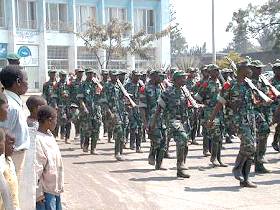





Kalashnikovs for Chickens: Small Arms Boom in East Africa
July 8, 2001

rafficking in small arms and light weapons along the Uganda, Sudan and Kenya borders is thriving, so much so that the cost of an AK-47 assault rifle has dropped from 10 cows in 1986 to two.
Ugandan army officials confirmed the availability of illegal light weapons in the region and blamed them for the rampant insecurity in southern Sudan, northern/north eastern Uganda, and north west/central Kenya. Soldiers, they say, have been deployed to try and control the situation. The weapons come from various sources including European dealers, renegade SPLA fighters, rebels of the Lord's Resistance Army, Ugandan vigilantes, UPDF soldiers and traders in the three countries.
"In one arms market near the Sudan-Uganda border, an automatic rifle goes for Ush 150,000 ($86), a pistol Ush 50,000 ($28) and a bullet Ush 200 ($0. 11). In Sudan, the weapons are much cheaper with an AK-47 costing the same as a chicken.
"The valley that runs between the Kidepo National Park and the Nangeye Mountains of Southern Sudan is the funnel through which small arms pour into Uganda. Each dealer carries up to five guns strapped to their backs at a time," states the report compiled by the British charity Oxfam.
The United Kingdom, it says, is the second largest supplier of the small arms in illegal hands, accounting for about 20-25 per cent of the trade while the other EU members account for 30 per cent. The present members of the UN Security Council combined supply 85 per cent of the arms which find their way into the illicit market through middlemen.
"The arms get to Uganda and its neighbours through a number of channels. An air freight company co-owned by a British citizen, using largely British crew, transported arms to Sudan in late 1998, but there were no controls in Sudan to stop them being sold to Ugandans," Oxfam states.
In Kenya, the arms available in the black market range from World War II Mark 4s to automatic weapons, the report says, while in the north of the country, a cow fetches 100 bullets. In Somaliland, where the present government is not recognised by several warlords, 170,000 people were killed with small arms between 1986 and 2000.
South Africa had a much higher rate. Thirty one people are short daily. Worldwide, the findings say, 500,000 people are killed annually by small arms. The report says Karamoja region alone has over 160,000 illegally-owned small arms. Between 1998 and 2000, 424 deaths and injuries from such arms were reported in three hospitals, while armed inter-ethnic cattle raiders left at least 100 people dead.
In Kitgum region, 40,757 people were displaced by armed raiders from Karamoja between April and May 2000 in Labwor and Agago counties, while 82,645 people who fled the violence have ended up living in eight camps.
Oxfam compiled the report following a visit to Northern Uganda by Mick North, father of a five-year old girl, Sophie, who was killed in the Dunblane School massacre in UK in March 1996. Mr North was on a worldwide crusade against small arms.
Chief David Longiro of Lobalangit in Karamoja is quoted as saying: " Here, the buying and selling of guns is an accepted way of life. Men travel hundreds of miles to look for the 'latest' weaponry."
Based on the new findings, Oxfam has launched a campaign against small arms trafficking while promoting peaceful conflict resolution.
Text source: Africa News, 7 May 2001
© 2001 CheckPoint |














